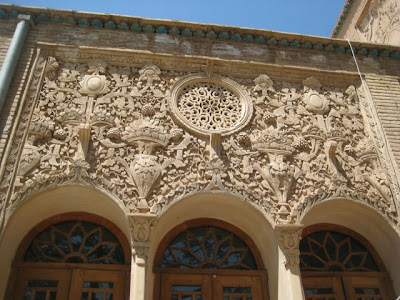Travelogue : Iran : Kashan, Abyaneh & Qom
03/06/09 : Kashan, Abyaneh and Qom
We paid an extra USD 50/pax for this excursion, with a van, guide (Mr Mehdi) and driver (don’t know his name, but his voice sounded like a typical villain out of a Hindustan film). It was worth it as the journey was far (about 500 km total). We started off at 8.30 am. Today, Raph’s assistant from the Iran office – Mr Fazaneh joined us.
Our first destination was Kashan. Kashan dates back to the Elamite period of Iran. The Sialk ziggurat still stands today in the suburbs of Kashan after 7000 years. Kashan is the first of the large oases along the Qom-Kerman road which runs along the edge of the central deserts of Iran. Its charm is thus mainly due to the contrast between the parched immensities of the deserts and the greenery of the well-tended oasis. We enjoyed the beautiful landscape of the mountains and a salt lake along the way. Couldn’t stop snapping away ;-)

Already halfway from Tehran to Kashan

Toll booth - if there is no one manning the booth, you go for free! Not expensive anyway. Petrol is only 35sen/litre
Kashan Fin Garden
First we arrived at Kashan Fin Garden. The garden covers a 2.3 hectares area with a main yard surrounded by ramparts with four circular towers. As usual, the design would have a mansion which combines architectural features of the Safavid, Zandiyeh and Qajar periods, fountains and moats flowing through. The cool water flowed from a spring on a hillside behind the garden. The water pressure is high enough to flow water to the pools and fountains without the need for mechanical pumps.

Mansion with fountain pool


The cooling pool...ahhh...
We could spend hours in the garden. It was hot outside, but the fin and cypress trees provided the shade. More on Kashan Fin Garden here.

The trees

Aksi! aksi! with Iranians (they're from Hamadan- birthplace of Ibnu Sina)
We then had lunch at a local restaurant where Mehdi told Raph to keep it down a bit (Raph couldn’t help it – he’s such a loud talker!) Apparently, Iranians like things prim and proper. They like to eat quietly. Hmm..
Borujerdi House
Next destination was the Borujerdis' House or Khāné-ye Borūjerdīhā. The house was built in 1857 for the bride of Haji Mehdi Borujerdui, a wealthy merchant. The bride came from the affluent Tabatabaei family, for whom Ustad Ali had built their house (The Tabatabaei House) some years earlier.
It is a traditional house, typical of Persian architecture. It consists of a rectangular beautiful courtyard, delightful wall paintings by the royal painter Kamal-ol-molk, and three 40 meter tall wind towers which help cool the house to unusually cool temperatures. It has 3 entrances, and all the classic signatures of Traditional Persian residential architecture such as biruni and daruni (andarun).
More on Borujerdi house here

Compound of Borujerdi House




the unique roof: contrary to what i read on the internet, we were not charged extra to go to the roof
love love hamam ^_^
It was another 2 hours journey to Abyaneh next. It is a traditional village and is one of the oldest in Iran where mostly the old folks are still living there. The young ones have moved to the city and only come back for celebrations such eid. The old folks have a unique traditional wear, with knee-length skirts and cute white fruity-flowery head scarf. The weather is cool here, as it surrounded by the mountains and is located at the valley. The people here made holes, like caves in the mountains and keep their livestocks in there
Syhh…there is an underground nuclear plant nearby Abyaneh, according to Raph. We couldn’t take pictures because there were soldiers guarding it.

the road to abyaneh

abyaneh traditional wear


Our waiter here is a Moussavi supporter. See the green ribbon on his wrist. He's a student studying medicine btw
We paid an extra USD 50/pax for this excursion, with a van, guide (Mr Mehdi) and driver (don’t know his name, but his voice sounded like a typical villain out of a Hindustan film). It was worth it as the journey was far (about 500 km total). We started off at 8.30 am. Today, Raph’s assistant from the Iran office – Mr Fazaneh joined us.
Our first destination was Kashan. Kashan dates back to the Elamite period of Iran. The Sialk ziggurat still stands today in the suburbs of Kashan after 7000 years. Kashan is the first of the large oases along the Qom-Kerman road which runs along the edge of the central deserts of Iran. Its charm is thus mainly due to the contrast between the parched immensities of the deserts and the greenery of the well-tended oasis. We enjoyed the beautiful landscape of the mountains and a salt lake along the way. Couldn’t stop snapping away ;-)

Already halfway from Tehran to Kashan

Toll booth - if there is no one manning the booth, you go for free! Not expensive anyway. Petrol is only 35sen/litre
Kashan Fin Garden
First we arrived at Kashan Fin Garden. The garden covers a 2.3 hectares area with a main yard surrounded by ramparts with four circular towers. As usual, the design would have a mansion which combines architectural features of the Safavid, Zandiyeh and Qajar periods, fountains and moats flowing through. The cool water flowed from a spring on a hillside behind the garden. The water pressure is high enough to flow water to the pools and fountains without the need for mechanical pumps.

Mansion with fountain pool


The cooling pool...ahhh...
We could spend hours in the garden. It was hot outside, but the fin and cypress trees provided the shade. More on Kashan Fin Garden here.

The trees

Aksi! aksi! with Iranians (they're from Hamadan- birthplace of Ibnu Sina)
We then had lunch at a local restaurant where Mehdi told Raph to keep it down a bit (Raph couldn’t help it – he’s such a loud talker!) Apparently, Iranians like things prim and proper. They like to eat quietly. Hmm..
Borujerdi House
Next destination was the Borujerdis' House or Khāné-ye Borūjerdīhā. The house was built in 1857 for the bride of Haji Mehdi Borujerdui, a wealthy merchant. The bride came from the affluent Tabatabaei family, for whom Ustad Ali had built their house (The Tabatabaei House) some years earlier.
It is a traditional house, typical of Persian architecture. It consists of a rectangular beautiful courtyard, delightful wall paintings by the royal painter Kamal-ol-molk, and three 40 meter tall wind towers which help cool the house to unusually cool temperatures. It has 3 entrances, and all the classic signatures of Traditional Persian residential architecture such as biruni and daruni (andarun).
More on Borujerdi house here

Compound of Borujerdi House


Soltan Amir hamam
I especially liked the Soltan Amir hamam. Just look at the design! I didn’t feel like leaving, just wanted to soak in the hamam ;-) I liked the special dome like roof too, it looked totally unique! You just have to love the designs and architecture!


the unique roof: contrary to what i read on the internet, we were not charged extra to go to the roof

love love hamam ^_^
the beautiful interior
Abyaneh
It was another 2 hours journey to Abyaneh next. It is a traditional village and is one of the oldest in Iran where mostly the old folks are still living there. The young ones have moved to the city and only come back for celebrations such eid. The old folks have a unique traditional wear, with knee-length skirts and cute white fruity-flowery head scarf. The weather is cool here, as it surrounded by the mountains and is located at the valley. The people here made holes, like caves in the mountains and keep their livestocks in there
Syhh…there is an underground nuclear plant nearby Abyaneh, according to Raph. We couldn’t take pictures because there were soldiers guarding it.
There is a Zoroastrian fire temple here. Abyaneh resisted conversion to Islam throughout the ages, and stayed Zoroastrian until the time of the Saffavid Shahs.

the road to abyaneh

abyaneh traditional wear

Last destination was Qom, about 2 hours from Abyaneh. Qom is a holy city for Shiites where they come for pilgrimage. It is the largest center for Shi'a scholarship in the world.
When we arrived Qom, it was already almost Maghrib. Mehdi asked us to visit the Fātimah al-Ma'sūmah (sister of Imām Alī ibn-Mūsā Riđā) shrine, but we politely declined. Also buried within the shrine are three daughters of ninth, Twelver Shī‘ah Imām, Muhammad at-Taqī. According to Mehdi, here at the shrine, Shiites pay their respects to Fatimah, make a tawaf around the shrine, and pray. Btw, females have to wear the chador to enter the shrine.
When we arrived Qom, it was already almost Maghrib. Mehdi asked us to visit the Fātimah al-Ma'sūmah (sister of Imām Alī ibn-Mūsā Riđā) shrine, but we politely declined. Also buried within the shrine are three daughters of ninth, Twelver Shī‘ah Imām, Muhammad at-Taqī. According to Mehdi, here at the shrine, Shiites pay their respects to Fatimah, make a tawaf around the shrine, and pray. Btw, females have to wear the chador to enter the shrine.
We had to do our last minute shopping at Qom bazaar as we just found out that the next day was a public holiday (Imam Khomeini’s 20th death anniversary). So all the shops, bazaars and tourist attractions would be closed! What a whammy!
We went straight to the bazaar instead to buy gaz (nuts), olive oil and soap, paneer, saffron sugar and Iranian tea.
It was almost 10pm when we finished, then we head for dinner. Luckily restaurants closed late, possibly because it was the eve of a public holiday, and coincidentally, there was a live telecast of a debate between Ahmadenijed and Mousavi. So everyone was glued on the TV set, including our guide and the waiters. By the time we were ready to go home (when the debate finished) it was already midnight. I bought some Rani juice drinks (later discovered that they are made in UAE actually hmmmph), then we took a group photo before going back. We reached our hotel at 2am. What a tiring, but fulfilling day!
We went straight to the bazaar instead to buy gaz (nuts), olive oil and soap, paneer, saffron sugar and Iranian tea.
It was almost 10pm when we finished, then we head for dinner. Luckily restaurants closed late, possibly because it was the eve of a public holiday, and coincidentally, there was a live telecast of a debate between Ahmadenijed and Mousavi. So everyone was glued on the TV set, including our guide and the waiters. By the time we were ready to go home (when the debate finished) it was already midnight. I bought some Rani juice drinks (later discovered that they are made in UAE actually hmmmph), then we took a group photo before going back. We reached our hotel at 2am. What a tiring, but fulfilling day!

Our waiter here is a Moussavi supporter. See the green ribbon on his wrist. He's a student studying medicine btw
To be continued : Tehran part 2
Labels: Travelogue













































































